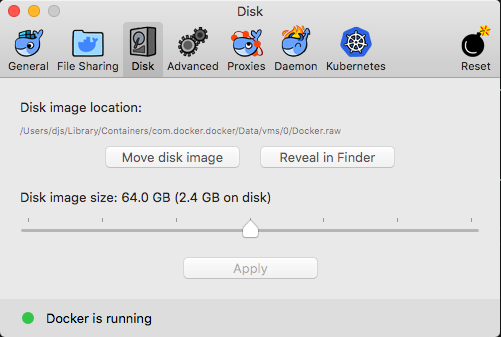Disk utilization in Docker for Mac
Estimated reading time: 3 minutesDocker for Mac stores Linux containers and images in a single, large “disk image” file
in the Mac filesystem. This is different from Docker on Linux, which usually stores containers
and images in the /var/lib/docker directory.
Where is the “disk image” file?
To locate the “disk image” file, first select the whale menu icon and then select Preferences.... When the Preferences... window is displayed, select Disk and then Reveal in Finder:

The Preferences... window shows how much actual disk space the “disk image” file is consuming. In this example, the “disk image” file is consuming 2.4 GB out of a maximum of 64 GB.
Note that other tools might display space usage of the file in terms of the maximum file size, not the actual file size.
If the file is too big
If the file is too big, you can
- move it to a bigger drive,
- delete unnecessary containers and images, or
- reduce the maximum allowable size of the file.
Move the file to a bigger drive
To move the file, open the Preferences... menu, select Disk and then select on Move disk image. Do not move the file directly in the finder or Docker for Mac will lose track of it.
Delete unnecessary containers and images
To check whether you have too many unnecessary containers and images:
If your client and daemon API are version 1.25 or later (use the docker version command on the client to check your client and daemon API versions.), you can display detailed space usage information with:
docker system df -v
Alternatively, you can list images with:
$ docker image ls
and then list containers with:
$ docker container ls -a
If there are lots of unneeded objects, try the command
$ docker system prune
This removes all stopped containers, unused networks, dangling images, and build cache.
Note that it might take a few minutes before space becomes free on the host, depending on what format the “disk image” file is in:
- If the file is named
Docker.raw: space on the host should be reclaimed within a few seconds. - If the file is named
Docker.qcow2: space will be freed by a background process after a few minutes.
Note that space is only freed when images are deleted. Space is not freed automatically when files are deleted inside running containers. To trigger a space reclamation at any point, use the command:
$ docker run --privileged --pid=host justincormack/nsenter1 /sbin/fstrim /var/lib/docker
Note that many tools will report the maximum file size, not the actual file size. To query the actual size of the file on the host from a terminal, use:
$ cd ~/Library/Containers/com.docker.docker/Data
$ cd vms/0 # or com.docker.driver.amd64-linux
$ ls -klsh Docker.raw
2333548 -rw-r--r--@ 1 akim staff 64G Dec 13 17:42 Docker.raw
In this example, the actual size of the disk is 2333548 KB, whereas the maximum size
of the disk is 64 GB.
Reduce the maximum size of the file
To reduce the maximum size of the file, select the whale menu icon and then select Preferences.... When the Preferences... window is displayed, select Disk. The Disk window contains a slider that allows the maximum disk size to be set. Warning: If the maximum size is reduced, the current file will be deleted and, therefore, all containers and images will be lost.